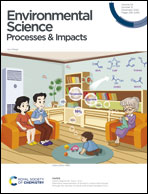Density functional theory explorations of parathion and paraoxon hydrolysis as a function of the underlying alkaline environment†
Abstract
Parathion, a once commonly used pesticide known for its potential toxicity, can follow several degradation mechanisms in the environment. Given the species stability and persistence, parathion can be washed into waterways from rain, and therefore an atomistic perspective of the hydrolysis of parathion, and its byproduct paraoxon, is required in order to understand its fate in the environment. Experimental studies have determined that pH plays an important role in the calculated hydrolysis rate constants of parathion degradation. In this work, the degradation of parathion into either paraoxon or 4-nitrophenol, and the degradation of paraoxon to 4-nitrophenol are explored through density functional theory using the M06-2X functional. How the level of basicity affects the reaction mechanism is explored through two different hydroxide/water environments. Our calculations support the anticipated mechanisms determined by previous experimental work that the formation of 4-nitrophenol is the predominant pathway in hydrolysis of parathion.

- This article is part of the themed collection: Contaminant remediation and fate


 Please wait while we load your content...
Please wait while we load your content...